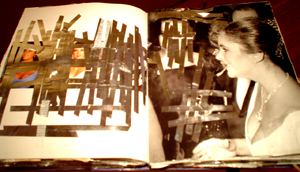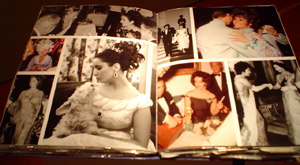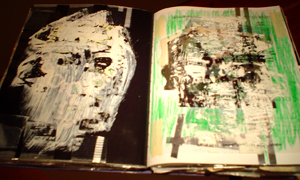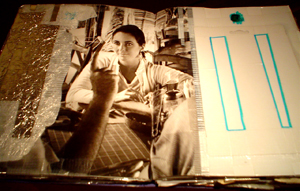
|
||
|
Portland art blog + news + exhibition reviews + galleries + contemporary northwest art
|
||
Scott Wayne Indiana's Liz Taylor Piece at Grey I Area 
I would like to defend Scott Wayne Indiana's "The Liz Taylor Piece" which appears in the last week of the concise and expertly curated (by TJ Norris) Grey I Area show at the Guestroom Gallery. Almost universally panned, this particular piece of SWI's presents some interesting aesthetic problems which I would like to explore. Isn't there something special about art that is universally despised? Often it seems like despicable art is that which discards accepted tropes of "the authentic" in favor of convoluted recursions of the acknowledged "inauthentic." Particularly despised are artists who acknowledge their own falsity and use it as an access point, a creative mode. The impulse to make art is basically a romantic one. It is founded on a romanticized view of individualism: that the individual is capable of a unique communication that culture at large could never produce or even approximate. The art object is a special product of the individual mind, retaining the aura of its creator, distinguished from say, an aluminum can. And yet there are so many working in this romantic endeavor who push against or dismantle their own basic position. One thinks immediately of Andy Warhol, who despite the phantasmagoric glitz now associated with his name, was essentially involved in the creative apprehension of total nihilism. His own words were always taken at face value, and seldom re-read, and this is understandable because his statements were rarely complex. When he said he loved Coke, and wished to make art that was more like Coke, no one understood the tension in that statement. Warhol expressed despair. The great romantic project of fine art had failed. It had become impossible and irrelevant to communicate the unique truths of individual experience. Authenticity within U.S.A. commercial capitalism was impossible, the romance of the individual had been completely supplanted by products as engines of identity. Coke disbursed the same elements of personality to everyone all over the world simultaneously. The existence of Coke had relieved humanity of the great burden of making art, because, for Warhol, it had homogenized identity; it had dismantled metaphysics into infinitely repeated red and white cylinders full of effervescent ambrosia. Warhol longed to be free from the burden of consciousness, of the romantic ideas of self-creation of individual identity. Like a pop culture Hamlet, he longed for rest from the difficult labors of identity and creativity, and the world was left to wonder what dreams surged restlessly beneath his endless repetitions. 
There are a number of artists who, like Warhol, tend to dismantle their own basic position. I think particularly of the poisoned, obnoxious paintings of Kenny Scharf, or the sick, rococo boredom of Jeff Koons. But what strikes me about Scharf, Koons, Warhol, and SWI is that their admission of the loss of authenticity, though convoluted, is essentially an authentic statement. It is the visual / aesthetic equivalent of someone telling you: "I am a liar, and I don't intend to change. I will never tell you the truth, although I am telling you the truth now." In a way this is a more "truthful" position than those who act within the centuries-old established authenticity tropes of visual art without ever examining them. By example, I like to form this argument in a simple series of questions: What is a landscape painting? Does it tell the truth? Or is it simply a regularized aesthetic system developed over several centuries? Is Bob Ross inauthentic because he abstracted a rule system that was free from natural observation? Or is that method (in fact) more authentic because it acknowledges the rule system in the abstract, as it is, free from any romantic metaphysical entanglements concerning the sublime experience of the individual in nature? Bob Ross represents the liberation of art from Romantic individualism, a possibility that Ross saw as spiritually democratizing and uplifting. He frequently denounced the intellectual / bohemian elitism romantic individualism seemed to imply: "You don't have to be special to do art. Anyone can do it. It's easy, just follow the rules." In Ross's happy little world, no one had to bear the burden of individual consciousness. There was no tension or dissonance. Art was simply an activity, and everyone who engaged in this activity by following along at home produced exactly the same thing. Where landscape painters had formerly sought to communicate the grandeur of their isolation, the sublime encounter of nature and identity, Ross nullified the sublime. Every cabin was the same cabin. Every wave was the same wave. Every mountain was the same mountain. They were simply components to be constructed into different arrays. Where romantic landscape painters sought to communicate their experience of power beyond the comprehension of their small identities, in Ross's landscapes there was nothing more powerful than the artist. Strangely, the omnipotence of the artist was totally banal, utterly without consequence. "You don't have to be special to do art." Ross's pupils were simultaneously infinitely powerful and totally without power. In Ross's program, the mystery and tension of art-making became totally subdued. Art became totally innocuous, the paintings so comfortable as to be less interesting than the raccoons Ross brought onto the program. Strangely, it wasn't that Ross had simplified the complicated techniques of rendering that made art harmless. Ross's system was actually incredibly complex and difficult to master. The crux of the matter was that Ross had solved the moral problems of art. Ross lifted the burden of romantic individualism. He eased the headache of the creative genius. Art no longer had the crushing responsibility of communicating truth. Art had no responsibility, except a recursive duty to the structure of its own system. Ross's landscape painting was a simple recursion that existed for itself and discarded all of the larger questions: the happy little world equals the happy little world. 
SWI's "Liz Taylor Piece" deals directly with the moral tension in making art that Ross had not only expunged but allowed to be upstaged by a raccoon. SWI begins with Liz Taylor's "My Love Affair with Jewelry," a massive coffee-table hardcover articulating its subject in equal parts glossy photos and text blurbs. This piece is clearly despicable, for reasons immediately obvious. There is no "artistic craft" evident at all, it merely seems to be a vandalized object, each page ruined with clear duct tape or white out, or the center of photographs simply torn out or scribbled over. The object has a presence of stupid brutality, it seems the work of a hostile, neurotic and incoherent teen-ager lashing out against the hypocrisy, injustice and frivolity of the American aristocracy, as embodied by Liz Taylor. The book chronicles Liz's blithe and capricious acquisition of gaudy diamond after gaudy diamond, and coyly celebrates her inimitable and uncontrollably raging avarice. SWI's statement follows: When I came across this book of Liz Taylor's jewelry, I was happy because I could tell that it needed to be fixed, and that I knew how to fix it. What you have before you is the fixed book. In this new fixed form, I believe the book more accurately depicts what is represented in the original, untouched version. SWI's final object suspends strange, contradictory tensions without easy resolution. Is this object even a product of creativity? The stronger argument is that it is the product of negative impulse: vandalism. And as vandalism it is not that severe. Why not simply burn the book and record the event? Wouldn't that be purer vandalism? Instead the vandalism is modulated by artistic interaction: the photographs seem to be defaced compositionally, the tape and white-out carefully considered. The actions are recklessly executed, but carefully considered. In my view, this is not an art object. It is SWI's way of addressing the problem of authenticity in art, and negotiating his own unease with creating precious, unique objects similar to the gaudy jewelry pictured in the book. 
Where Bob Ross simply nullified the serious burden of art as individual expression, SWI thrashes against it, fights it, lashes out. The same problem, for SWI, is not as easily reconciled. Where is authenticity in art? Is SWI's vandalism an authentic act, or merely theatrical posturing? Does the "Liz Taylor Piece" communicate some convoluted truth (Like: "I feel incapable of real communication" ) or is it simply visual static, the spastic aesthetic fibrillations of despair? I see SWI's enigmatic piece as reverse Warhol, an immediate observation of the slickness, reproducibility, and predatory avarice of transacted / leveled / modulated identity (like Warhol's relationship to Coke) attacked through the simple tactile process of tearing, cutting, and sticking. In defense of this work it is perhaps better to think of the object as the artifact of a performance rather than as a sculpture. The performance "The Liz Taylor Piece" represents is the simple act of touching this book, of using your hands to tear its pages. SWI simply set up a limited system of aesthetic interaction with this object and allowed a free interchange to take place, really, a highly complex negotiation between creative impulse and destructive impulse. So, "The Liz Taylor Piece" exists within the problem of authenticity in art, somewhere in the grey area. It remains wholly unresolved. It is unclear whether it is an authentic expression or merely a limited but impulsive aesthetic game. It is unclear whether it is an art object or just the product of haphazard activity. It does not reveal or express anything about the identity of the artist, but instead uses Liz Taylor's publicly constructed identity as a prop in a half-hearted and reckless game. It dodges the great burden of art as expression of consciousness and instead fibrillates helplessly, short-circuiting. But really, there is something beautiful in this helpless, pathetic, adolescent object. It is the same kind of beauty one witnesses watching a teenager puncture car tires with a pocket knife; it is that they are free from the burden of consciousness, that their actions have no implications, that they don't need to know why, only how. That they will never feel paralyzed. It is the hope that you don't need to be special to make art. Information on the Guestroom site is available at Guestroom Gallery Posted by Isaac Peterson on July 27, 2006 at 0:00 | Comments (7) Comments Wow, your writing is really nice, Isaac. I enjoyed reading your piece. Kudos for having the vision to see this project for something more than what it appears on the surface. I really enjoyed seeing the piece through your eyes, learning a bit more art history, and being provoked to think more deeply about the art. Nice job. Posted by: Kim Upham All I can say is, there is a reason that TJ Norris got Scott Wayne Indiana's work in this show. And from seeing the rest of the show, I am assuming it is a very good reason. So I also am assuming that you aren't the only person that isn't "panning" this piece. Posted by: Calvin Carl Isaac, thank you for such a thorough and thoughtful defense of Scott's piece, but I have to take issue with your logic. First off, it would seem that those who are universally panning this piece probably agree with your assessment of the book as a "clearly despicable ... helpless, pathetic, adolescent object." Also, the image you conjure up of an unconscious tire-slashing teenager is way off mark. This is just a romanticized, cinematic gesture for teen angst. Sure, there's beauty in that action, but it's the beauty of Buzz slashing Jim's tires and the ensuing knife-fight and fatal chicken-race. And when did Liz Taylor become the poster-girl for American frivolity and aristocracy? That argument might have held water in the 60s and into the 70s, but the image of Liz Taylor represented in Scott's book is now one of nostalgia. It seems that Scott is not so much lashing out against the oppressive regime of jewelry-loving celebrities but rather taking a seductive and shiny object and "fixing" it by making it more seductive and shinier. Finally, Bob Ross solving the moral problems of art and nullifying the "serious burden of art as individual expression?" Please tell me you're being facetious. This is probably the strangest defense of a work of art I have come across in a long while. And while I believe you genuinely support the artist's efforts, in the end your praise reads as "it's so bad that it's good!" Posted by: MB yes, point taken. As I was writing this it occurred to me that it was indeed very strange. I agree entirely with your observation that the materials SWI chose in fact make the book more opulent, it is actually very seductive. I do think that Bob Ross represents a sort of death of romantic individualism, even though he may embody a different kind of romance, like a Marxist romance perhaps? diffusing romance so that everyone had access to it? Setting up a rule system for Romance so that the entire idea is powered by emulation rather than creativity? Liberating romance from the "genius" and into the hands of the common man? His happy little world was always a very romantic place, even if it was only an easily replicable array. So, his dissemination of romance was uplifting in a communist sort of way, art was not special, it was a trade easily acquired by the industrious student. But It was Marx who brought material gravitas to the pure abstraction of philosophy. He said "Hey, maybe we should be looking at the real world, and not just discussing everything in theory." Ross's system, while in line with Communist politics, was pure abstraction, it was like a mathematics of landscape painting. Every cabin could be reduced to a pure, abstract concept of a cabin, every mountain could be reduced to a pure, abstract concept of a mountain. Ross's system was Marxist politically but not philisophically, because Marx dismantled abstraction in favor of material reality. The only solution to this conflict would be a SWI style vandalization of a Ross system landscape. I think that cinema and Romanticism, although perhaps once aligned, are now opposed ideas. Cinema has become systematized and totally anti-romantic. The tropes of cinema have evolved and ossified to such an extent that they are now totally non-expressive and predictable. The image of teenagers slashing car tires is certainly cinematic, but then again I think even the idea of the existence of teenagers is derived from cinema. I mean, did adolescence even exist before the 50's in America? It was invented by James Dean and 60's surf movies as an expression of the post-war population explosion. It was a purely abstract, cinematic construction which progressed along the lines of any aesthetic system, by constantly referring to itself. Thus Grease, made in the late 60's refers not to the cultural revolution, but rather to identity construction and rebellion in the 50's, located where it is more easily circumscribed through cloying nostalgia. Grease II refers not to the 70's, but rather to Grease I, which refers back to the 50's. Thus cinema progresses teenagerness on a purely aesthetic level, suspending the complications, interference and permutations of passing time. This is why so much TV and cinema continues to focus on teenagers, it's a symbiotic interchange in which each predicts, controls and shapes the other in a suspended state. To be a teenager is to exist in this suspended state, outside of the complications of the present, floating in a purgatory of the recursively imagined 50's. It is easy to compile teenage "experience" into a two hour plotline, with clear pro/ antagonist, exposition, rising action, climax and denouement. Similarily, young people involved in the difficult process of constructing complex identities search desperately for behavioral models, which culture endlessly proliferates. The end result is a massive self-feeding recursion, high-decibel metaphysical feedback. Aren't the cultural ceremonies we offer teenagers just totally hyperbolic, cinematic deceptions? Like the grandiose rites of high school graduation/ prom/ etc. It's kind of like "This is the big scene at the end of the movie, and that's all you get. Welcome to the world, suckers!" High School graduation is the big cinematic climax, and afterwords the movie ends! It ushers teenagers into the moral ambivalence and metaphysical revulsion of adulthood. I think punk things like slashing tires etc. are kind of a romantic resistance to cinema: an assertion of the boredom and pointlessness of individual experience, an exploration of real experience! In a way, vandalism is a way of recovering romance from the cinematic anti-time suspension of teenagerism. Teenagers want to be caught, because it affirms their real existence in the present. Oh, a transgressive romance with the real, with right now, that deserves punishment! What could be more Romantic (or more banal)? It's funny how when cinema flows over the simple mechanics of everyday life, when it overtakes the banal, it is the banal which then becomes romantic. Asserting the banal becomes an act of aesthetic resistance. I think of SWI's piece as along the same lines, like an assertion of the romantic notions of individual identity within the glamorous cinema of culture (Liz T., although truly not as glorious an emblem as 3 decades ago). This assertion is by necessity un-glamourous/ unmasterful/ destructive/ close to boring. I guess when I say SWI's piece is pathetic/ neurotic, etc., I don't really intend it as "criticism" viz. suggestions for improvement/ growth as an artist. I am just trying to honestly understand the aesthetic of the work. I think it's clear that if it is indeed "bad" it is consciously so, made that way by the artist on purpose. I am interested in why the artist would do that. One of my favorite artists is Mike Kelley, whose work can only be described as pathetic / adolescent / helpless / despicable especially in pieces where he merely places a sock monkey face down in an empty gallery. One of his performances consisted only of a group of nude men and women having sex with stuffed animals in an art gallery. And where this performance seems totally repulsive / pathetic/ adolescent, and I wouldn't really want to see it, I admire his art because I think that there is some meaning in purposefully being pathetic and adolescent in a culture that prizes efficacy and defines happiness as equal to material luxury. Kelley's artist statement identifies the controlling forces in American culture as capitalism and Freudian psychology (i.e. sublimation and pathology of sexual desire as a male power), and his art builds an aesthetic which simply opposes those structures, I suppose without offering any constructive alternative.
Posted by: Isaac One of my favorite artists is Steve McQueen, whose piece "Deadpan" might be described as helpless. I also like telling people that one of my favorite artists is Steve McQueen to confuse them. I imagine this conversation would be riveting over a pitcher of espresso in some neobeatnik cafe, but flickering on my computer screen in 8 point font is just too much. I saw that you mentioned Marx and Grease II, but honestly, I didn't read on to see if you meant Karl or Harpo. Posted by: MB Just briefly chiming in here to note that Indiana's work was a "component" of an overall exhibition subtext, and therefore, though the review was tardy and the debate continues, with an exhibition now de-installed, for me, it seems belaboured. Port provided a review of the show, and that review (by a guest writer) was intentioned for "Big, Red & Shiny" (out of Boston). We tried so hard to break the growth barrier, but somehow it was awkwardly reigned. Port chose to provide this slice for debate, which I am both always up for, and appreciate. Though, my question is, where was this same crowd, the larger dialogue, for our gallery talk "Tone, shade & other in-betweens" back in June? I encourage the readership of Port to get away from the keyboard and into the galleries more often. The sensory nature of the work proved itself. Posted by: TJ Norris Dear Isaac, Thanks for placing art (even this "clearly despicable ... helpless, pathetic, adolescent object") back into the world. So many people (MB included) seem to view art as hovering above the earth in some "noumenal" atmosphere with its own rules. SWI was commenting on this phenomenon, and your criticism clarifies this fact. Nice writing! Would love to sit down with you sometime over a "pitcher of espresso" (huh?) and talk about the romantic individual and authenticity in art and in love and in adolescence. Your writing is always an inspiration! Posted by: JRH Post a comment Thanks for signing in, . Now you can comment. (sign out)
(If you haven't left a comment here before, you may need to be approved by
the site owner before your comment will appear. Until then, it won't appear
on the entry. Thanks for waiting.)
|
| s p o n s o r s |
 |
 |
 |
 |
 |
 |
 |
 |
 |
 |
 |
 |
 |
 |

|
Site Design: Jennifer Armbrust | • | Site Development: Philippe Blanc & Katherine Bovee | |


![[TypeKey Profile Page]](http://www.portlandart.net/nav-commenters.gif)